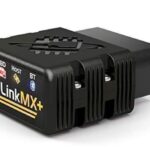For automotive repair professionals and enthusiasts alike, having a reliable OBD scanner is indispensable. When it comes to diagnosing vehicles, especially those spanning different eras of automotive technology, the question often arises: what is the Best Obd 1 2 Scanner available? The answer isn’t always straightforward, and sometimes, looking to the past can provide surprisingly effective solutions.
Snap-on scanners have long been a respected name in the automotive diagnostic world. Many mechanics, including myself, have relied on their tools for years. While newer, touchscreen Snap-on scanners boast advanced features, there’s a strong case to be made for their older counterparts, particularly when dealing with OBD1 vehicles alongside OBD2.
The older Snap-on MT2500 and MTG2500 scanners, often referred to as the ‘brick’ scanners due to their robust design, are surprisingly capable when it comes to OBD1 systems. These are the tools that were workhorses in auto repair shops for decades, and they continue to hold value today. The speed at which they transfer data from older OBD1 vehicles is impressive, often matching or even exceeding the performance of newer scanners in this specific application.
One might assume that newer scanners offer significant advantages in data capabilities. However, when directly comparing a modern, touchscreen Snap-on scanner to an older MT2500 on an OBD1 vehicle, the difference in viewable data points is minimal. Newer scanners might display ten data points, while the MT2500 shows eight. Interestingly, the data presentation on the older ‘brick’ scanners can even be argued as more user-friendly. The closely spaced data on the MT2500 can be easier to read at a glance compared to newer screens where data point names and values are spread across the display. For comprehensive OBD1 diagnostics, the MT2500 provides excellent data coverage.
The MTG2500 does offer graphing capabilities, but its practical use in OBD1 diagnostics is limited and can sometimes be unstable. For OBD1 vehicles, graphing is often less crucial because the data values transmitted to the scanner are frequently interpretations by the Engine Control Unit (ECU), rather than direct sensor readings. Therefore, the raw sensor data graphing becomes less relevant depending on the specific data point and vehicle manufacturer. In practice, graphing is rarely necessary for effective OBD1 diagnostics.
While the MT series scanners with appropriate cartridges can function on vehicles up to the mid-2010s, for vehicles from around 2006/2007 onwards, a higher-level Snap-on scanner is generally recommended due to increased memory and speed demands of newer systems. However, for older vehicles, a cost-effective MT2500 with cartridges from around 1999 can be an exceptional tool.
The real advantage of investing in Snap-on scanners, especially older models, lies in their versatility across both OBD1 and OBD2 systems. Once you have invested in the necessary cables and adapters, you gain broad compatibility. They also offer substantial capabilities for OBD2 vehicles. While software upgrades for Snap-on can be expensive for DIY users, the initial investment in a used MT2500, for example, can be quite reasonable. Often, these older scanners are available at good prices used, or you might even know someone willing to lend one.
In conclusion, while not explicitly advocating for Snap-on as the only option, based on personal experience, older Snap-on scanners like the MT2500 and MTG2500 are strong contenders for the title of the best OBD 1 2 scanner, particularly when considering cost-effectiveness and robust performance on older OBD1 systems, alongside their OBD2 capabilities. They represent a valuable and often overlooked option for mechanics and automotive enthusiasts needing to diagnose a wide range of vehicles.

